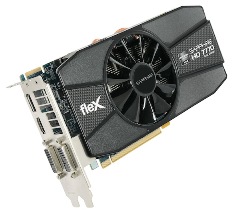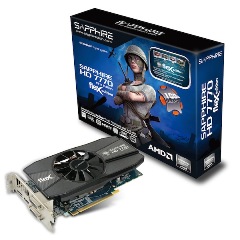
SAPPHIRE Technology ha appena annunciato la scheda SAPPHIRE HD 7770 Flex Edition, che abbina le già apprezzatissime caratteristiche dell'architettura GCN di AMD alla soluzione per la grafica multischermo esclusiva di SAPPHIRE.
SAPPHIRE HD 7770 FleX porta la grafica multischermo facile da configurare al grande pubblico; la tecnologia FleX consente di utilizzare monitor DVI economici per i primi tre schermi in modalità orizzontale o verticale, offrendo così una soluzione economicamente vantaggiosa per il gaming e altre applicazioni business multischermo. Utilizzando anche l'uscita DisplayPort, la SAPPHIRE HD 7770 FleX può supportare quattro schermi in modalità Eyefinity.
La scheda HD 7770 FleX fa parte della serie SAPPHIRE GHz e viene fornita con 1 GB di memoria DDR5 con frequenza di 1125 MHz (4,5 Gb/sec effettivi) e core clock di 1000 MHz.
Per gli appassionati delle massime prestazioni è disponibile per il download gratuito dal sito web di SAPPHIRE una nuova versione del tool di overclocking di SAPPHIRE TriXX, che consente la regolazione della tensione della GPU, delle velocità di clock e il monitoraggio della temperatura. La scheda supporta il controllo manuale della velocità della ventola, con creazione di profili utente e fino a quattro diverse configurazioni di prestazione.
La serie HD 7000 è la terza generazione di soluzioni compatibili con DirectX 11 prodotte dalla divisione grafica di AMD, ex ATI. La scheda SAPPHIRE HD 7770 FleX è predisposta per DirectX 11.1 e per il nuovo sistema operativo Windows 8. La comunicazione con il PC host è ottimizzata tramite l'implementazione della più recente interfaccia ad alta velocità PCI-Express Gen3.0, mentre per incrementare ulteriormente la prestazione è possibile usare più schede in modalità CrossFireX con una scheda madre dalle specifiche idonee.
Anche le specifiche HDMI sono incrementate nella serie HD 7000. Fast HDMI 1.4a supporta la funzionalità Stereoscopic 3D con velocità di frame ottimizzate di 60 Hz per occhio, per un totale di 120 Hz. La scheda è predisposta anche per la nuova generazione di monitor da 4 K, che possono essere gestiti da un singolo ingresso ad alta velocità della porta 3 Ghz HDMI 1.4a o DisplayPort 1.2 HBR2.
Il nome "APP Acceleration" descrive l'ottimizzazione delle prestazioni di un'ampia gamma di applicazioni che utilizzano le funzionalità di stream processing e le specifiche di hardware della nuova architettura grafica. La serie HD 7000 è ottimizzata per questo tipo di attività. Le applicazioni tipiche includono encoding e decoding video, compressione e multiplazione per distribuzione di media, attività di gaming e videoconferenze. L'"APP Acceleration" migliora anche attività comuni come la navigazione Internet, le applicazioni Office e la compressione dei file con le suite di software supportati.
Nota: La maggior parte delle schede grafiche basate sulla tecnologia AMD richiedono per la connessione del terzo monitor in configurazione Eyefinity un monitor DisplayPort o connesso a un adattatore DisplayPort attivo. Le schede della famiglia SAPPHIRE FleX supportano tre monitor DVI in modalità Eyefinity e forniscono una vera area di lavoro SLS (Single Large Surface) senza la necessità di adattatori attivi. I primi due monitor sono connessi alle due porte DVI e il terzo a un cavo da HDMI a DVI (in dotazione) senza necessità di alcun hardware attivo supplementare. Le uscite DisplayPort restano disponibili per il collegamento di ulteriori monitor, per esempio la scheda SAPPHIRE HD 7950 FleX, presentata recentemente, grazie alle due uscite DisplayPort consente di supportare fino a 5 schermi in modalità Eyefinity.

[Immagine ad alta risoluzione]

[Immagine ad alta risoluzione]

The SAPPHIRE HD 7770 FleX brings easily configured multi-screen graphics to the mainstream. The FleX feature enables users to connect low-cost DVI monitors for the first three screens in landscape or portrait mode providing a cost-effective solution for increased productivity in content creation and editing applications as well as for display systems or multi-screen gaming. By also using the DisplayPort output, the SAPPHIRE HD 7770 FleX can support four screens in Eyefinity, providing additional display options.
The SAPPHIRE HD 7770 FleX is a member of the SAPPHIRE GHz series, and ships with clock speeds of 1000MHz for the core and 1125Mhz (4.5Gb/sec effective) for the 1GB of on board high speed DDR5 memory. For enthusiasts wishing to maximise performance, a new version of the SAPPHIRE overclocking tool, TriXX supporting this latest generation of technology is available free to download from the SAPPHIRE website. TriXX allows tuning of GPU voltage as well as core and memory clocks, whilst continuously displaying temperature. Manual control of fan speed is supported, as well as user created fan profiles and the ability to save up to four different performance settings.
The HD 7000 series is the third generation of DirectX 11 compatible solutions from the graphics division of AMD - formerly ATI. The SAPPHIRE HD 7770 FleX is ready for DirectX 11.1 and the new Windows 8 operating system as well as delivering all the features of the current DirectX 11 such as DirectCompute11 and multi threaded communications with the CPU. Communication with the host PC is optimised with the implementation of the latest high speed PCI-Express Gen3.0 interface, and multiple cards can be used to further enhance performance in CrossFireX mode on a suitably specified mainboard.
HDMI specifications have also increased in the HD 7000 series. Fast HDMI 1.4a supports Stereoscopic 3D with enhanced frame rates of 60Hz per eye - 120Hz total. It is also ready for the next generation of 4K displays that can be driven from a single high speed input of 3GHz HDMI 1.4a or DisplayPort 1.2 HBR2.
APP Acceleration is the name given to the enhanced performance of a wide range of applications using the stream processing capabilities and specific hardware features of the graphics architecture. The HD 7000 series has been optimised for this type of task. Typical applications include Video encoding and decoding, compression and multiplexing for media distribution, gaming or video conferencing. APP acceleration can also enhance everyday tasks such as Internet browsing, Office applications and file compression with supported software suites.
Note: Most graphics cards based on AMD technology require the third monitor in an Eyefinity set-up to be a DisplayPort monitor, or connected with an active DisplayPort Adapter. The SAPPHIRE FleX family can support three DVI monitors in Eyefinity mode and deliver a true SLS (Single Large Surface) work area without the need for active adapters. The first two monitors are connected to the two DVI ports and the third to an HDMI to DVI cable (supplied) with no extra active hardware required. The DisplayPort outputs are still available for the connection of additional monitors – for example the recently announced SAPPHIRE HD 7950 FleX with its two DisplayPort outputs can support up to 5 screens in Eyefinity.
Source: Hightech Information System (HIS) Press Release
Links



